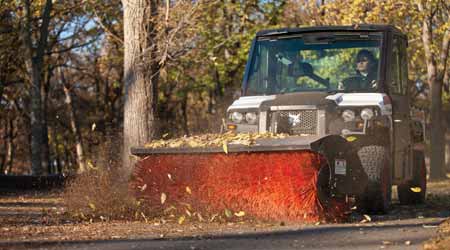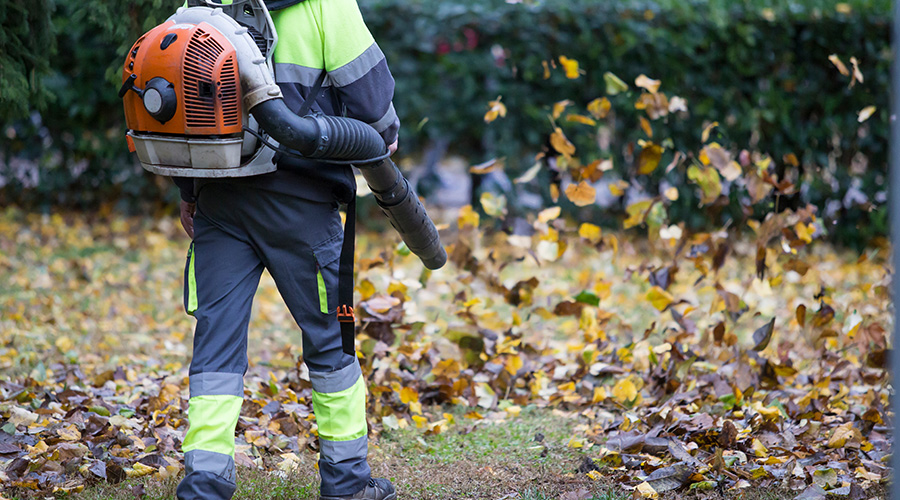 Utility vehicles help technicians with the Cordova Recreation and Park District more efficiently maintain 38 parks covering more than 400 acres.
Utility vehicles help technicians with the Cordova Recreation and Park District more efficiently maintain 38 parks covering more than 400 acres.Grounds: Utility Vehicle, Water and Security Issues
Utility vehicle use, water conservation and security issues shape manager’s decisions in maximizing the appearance and health of parks
California is a world away from Michigan in many ways, as Gerald Dobbs found out quickly five years ago.
“It’s a very different climate,” says Dobbs, park services superintendent with the Cordova Recreation and Park District in Rancho Cordova, Calif. “I’m dealing more with the public because the public wants to know what’s going on in the parks, and they alert us when they see issues in the parks. That wasn’t happening before.”
“Before” refers to his previous position as landscape services manager with Michigan State University. The transition from the temperate climate of an Upper Midwest campus to the sunshine of the West Coast has presented Dobbs with unexpected challenges, including a soil challenge created by the Gold Rush and issues familiar to most grounds managers, such as cost-effectively managing an aging fleet of utility vehicles and other equipment as the department’s workload expands.
Spotlight on utility vehicles
The grounds equipment issues that Dobbs faces are partly a function of the size of the district, which covers 75 square miles. The district’s 38 parks have a total of about 400 acres. To maintain an area this size, the department relies on a fleet of 35 trucks — primarily pickup trucks that move staff and materials among jobsites — and five utility vehicles.
“The utility vehicles are dedicated to specific parks,” Dobbs says. “At our major sports center, we have two or three vehicles out there, where it has about 15 acres. We have two (vehicles) here at Hagan Park, which is more than 80 acres, and these guys are responsible for picking up litter, cleaning restrooms and drinking fountains, and servicing all the picnic table areas.” The department’s equipment arsenal also includes two backhoes and front-end loaders, one farm tractor with various attachments, a compact trencher, two large riding mowers and six trim mowers.
Besides the parks, Dobbs also oversees an 18-hole golf course.
“We have a fleet of about 40 golf carts, and the maintenance shop there has four more utility vehicles for use in maintaining the golf course,” he says. “We like the utility vehicle concept. They’re fuel efficient and maneuverable.
“We want to add at least two or three more units because our district is growing. Since I’ve been here, which is five years, we’ve added five new parks. One park we added is about 20 acres, so we’re trying to get a utility vehicle to help service that park and keep it dedicated out there. It’s not only for our (maintenance) detail guys but for the recreational sports folks because there are four sports fields out there that need to be striped and so forth.”
Grounds managers in all types of facilities — but especially those facilities that rely on public funds — understand very well the challenges that Dobbs faces in being forced to extend the performance life of big-ticket equipment as long as possible.
“We’ve been trying to replace equipment since I’ve been here, but it’s been difficult because of other priorities. So I’ve been asked to keep these pieces of equipment running for three or four more years. So we’ll have to increase our budget for service and supply costs because the older equipment gets, the more expensive repairs become. The equipment just wears out.”
The cost of big-ticket equipment often puts new purchases nearly out of reach for many departments.
“To buy (a riding mower) outright, you’re talking over $100,000 in California,” Dobbs says. “If we look at leasing one on an annual basis with a service contract, it’s more cost-effective over a 10-year period versus buying it outright.
“We found out through one of our vendors that we can lease large mowing equipment, as well as smaller units, and have a service contract to go along with it. I currently have only one mechanic. I used to have three mechanics, but we were downsized. That has made repairs very challenging, and we’re looking at using outside vendors for things like tire changes and oil changes in order to free up our current mechanic for more technical types of repair work.”
Related Topics:














